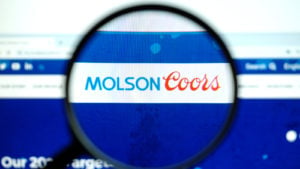
If you’re looking for cheap stocks to buy, Canada’s national newspaper, The Globe and Mail, had an article from the Contra Guys, Benj Gallander and Ben Stadelmann.
The duo run an investment newsletter, Contra the Heard, which focuses on undervalued and unloved stocks. Their Globe article had to do with Ambev (NYSE:ABEV), the Brazilian subsidiary of Anheuser-Busch InBev (NYSE:BUD), the world’s largest beer company, whose share price has fallen from $9 in 2013, to $2 in 2024.
Their observations got me thinking about stocks in a similar position. Certainly, it’s not an easy task, given the markets are fairly expensive based on an S&P 500 P/E ratio of 24.2x. That’s considerably higher than 19.7x a year ago. Currently, it exhibits low price-to-book ratios, revenue growth, consistently profitable, reasonable debt levels and plenty of share liquidity.
Based on these criteria, let’s examine three cheap stocks to buy from the S&P 500.
Molson Coors Brewing (TAP)

Molson Coors Brewing (NYSE:TAP) has a P/B ratio of 0.81x, slightly less than its five-year average, but considerably less than the 5.04 multiple for the index itself.
TAP is known for beer brands such as Coors Light, Miller Lite, Coors Banquet, Miller High Life, Molson Canadian, Carling, Madri, Blue Moon Belgian White and Leinenkugel’s Summer Shandy. It is the fifth-largest brewer in the world behind BUD, Heineken (OTCMKTS:HEINY), Carlsberg (OTCMKTS:CABGY) and China Resources Beer Holdings.
TAP shares have lost 23% and 8% of their value over the past year and five years, respectively. The good news is that BUD, its biggest rival over its history, has done even worse, down 32% over the past five years. By comparison, BUD’s P/B is 1.44x, or 78% more expensive based on each company’s book value.
Molson Coors Brewing has a three-year annualized revenue growth rate of 6.62% with a three-year annualized operating income growth rate of 5.51%. Its net debt is $5.76 billion, or just 22% of its total assets. Based on its trailing 12-month free cash flow of $1.40 billion and an enterprise value of $16.66 billion, it has a free cash flow yield of 8.4%. Anything over 8% is value territory.
Franklin Resources (BEN)

Franklin Resources (NYSE:BEN) has a P/B ratio of 0.91x, slightly less than its five-year average of 1.18x, and considerably less than the 5.04 multiple for the index.
The ETF hasn’t been good for active asset managers like Franklin Resources, the parent company of Franklin Templeton mutual funds. BEN shares have lost 19% and 37% of their value over the past year and five years, respectively.
One of its mutual fund competitors, T. Rowe Price Group (NASDAQ:TROW) has done slightly better, up 3.5% over the past five years, but still well behind the index’s 85% return over the same period.
Furthermore, Franklin Resources has a three-year annualized revenue growth rate of 12.14% with a three-year annualized operating income growth rate of 1.67%. BEN’s net debt is $9.04 billion, or just 28% of its total assets.
As of May 31, Franklin Resources had $1.64 trillion in assets under management, 16.5% higher than at the end of May a year ago. In the first six months of fiscal year 2024 through March 31, it managed to stem the net outflows. It generated a $1.9 billion increase in long-term net flows, up from long-term net outflows of $14.6 billion a year earlier.
Trading at one of its lowest points in the past five years, this cheap stock is ripe for the pickings.
Mohawk Industries (MHK)

Mohawk Industries (NYSE:MHK) has a P/B ratio of 0.94x, slightly less than its five-year average, but much less than its multiple of 2.2x at the end of 2022.
The company’s shares have gained 4% over the past year but lost 27% over the past five years. As recently as January 2018, MHK traded over $280.
The company, which manufactures all kinds of flooring, currently faces headwinds related to higher interest rates, lower new home construction, and fewer large renovations. However, the company is optimistic about the future.
“Residential flooring sales should lead the recovery as consumer confidence improves, the housing market strengthens, and postponed remodeling projects are initiated. Existing home sales will normalize and are a meaningful catalyst for flooring since homeowners replace it more often before listing a property or soon after completing a purchase,” stated its Q1 of FY 2024 press release.
Mohawk has a three-year annualized revenue growth rate of 5.24%. And, its three-year annualized operating income declined by 2.48% over this period. Its net debt is $2.40 billion as of March 30, or just 18% of its total assets.
I would say this is the contrarian play of the three. It’s due for better days ahead.
On the date of publication, Will Ashworth did not have (either directly or indirectly) any positions in the securities mentioned in this article. The opinions expressed in this article are those of the writer, subject to the InvestorPlace.com Publishing Guidelines.
On the date of publication, the responsible editor did not have (either directly or indirectly) any positions in the securities mentioned in this article.




